No matter what, I planned to go to the 16th annual memorial rally in memory of assassinated Prime Minister Yitzhak Rabin. Just as I have for the past 15 years. Just as I did on that fateful Saturday night, November 4th, 1995, when I went to the mass rally For Peace and Against Violence that was organized to counteract the slander campaign being carried out against the Prime Minister. It was at the end of that rally that Rabin was shot three times by Jewish terrorist Yigal Amir.
This year the Rabin family decided not to head the organizing committee for the rally, as they had for the previous 15 years. Perhaps they were afraid that the people wouldn’t come. Perhaps they felt it was time to move on.
In their place, a 4th of November 1995 non-profit organization was established, and the baton was passed on to them to keep the flame alive. Heading it was Hemi Sal from Kibbutz Ein Shemer, who runs a production company and was involved in the organization of all of the previous rallies, including the original 1995 demonstration.
 |
| Hagit Ofran; podium reads “Yes to Peace!” |
The quote in the headline, “We are here, we have no fear,” comes from the courageous Hagit Ofran. Ofran is head of Peace Now’s Settlement Watch Committee, and she told the crowd that she had been at many previous rallies, but this was the first time she was ever on the stage. Everyone knew why. She has been targeted by the extreme right, because of her diligent watchdog work following the settlement activities in the West Bank and East Jerusalem. The week of the demonstration, graffiti was written on the stairwell to her home “Ofran, Rabin is waiting to meet you”– a clear death threat.
Ofan’s response was that she may have been targeted, but “the taunts are in all our stairwells. The [price] tag may have been marked for me, but we all pay the price. We must not fear. We are here, and we are many. We have a voice, and we must raise it.” She has a much quieter persona than her angry prophet grandfather Prof. Yeshayahu Leibowitz, but the power of her personality and actions are clear to all, both friend and enemy.
This year’s rally was much more political than recent rallies, beginning with the opening speech by former Education Minister and Meretz leader Yossi Sarid, who presented a powerful critique of the current reality and trends, with a call to action, in his masterful Hebrew prose, though his description of Rabin’s heritage left something to be desired. Yes, Rabin believed in the necessity of force, and also knew the limits of force. Yes, Rabin felt that no stone should be left unturned in the quest for peace. Yes, inspired by his mother “Red” Rosa Cohen’s socialism, he believed in social justice and a rearrangement of the national priorities in a fairer and more egalitarian manner. However, to say that Rabin’s legacy included a defense of democracy and the authority of the courts? Did Sarid forget that Rabin once said that he envied leaders who didn’t have to contend with Btselem and the High Court of Justice?
Eldad Yaniv of the National Left said it was time to leave memorials behind, time for action to change the situation in the spirit of the summer social protest movement, “time to leave the dead Rabin behind, but to act in the spirit of Rabin’s living legacy.”
Orthodox writer Sahara Blau described how the assassination marked a turning point in national religious Jewry, with the majority moving towards Orthodox right-wing extremism – while she felt more and more uncomfortable being identified as a religious Jew, who wanted to be part of the sane and moderate mainstream of Israeli society. After the assassination she actually changed her way of dressing so that she would less automatically identifiable as a religious Jew.
Three young teenage female youth leaders from the progressive Zionist youth movements Hanoar Haoved, Machanot Ha’olim and Hashomer Hatzair, quoted from Rabin’s speeches, and issued a powerful call on behalf of all the youth there who are committed to changing the Israeli reality for the better.
And as somewhat comic relief, Rabbi Menachem Froman from the Tekoah settlement, appearing in all-white ultra-Orthodox outfit which he explained was a counterpoint to the black worn in Meah Sha’arim and other bastions of religious conservatism, said that, “we are not right or left, we are all for peace.” He described how he recently visited Palestinian President Mahmoud Abbas in Ramallah to introduce him to a new settler peace movement, and a number of times tried to lead the crowd in a chant of “Shalom, shalom, shalom.”
The rally was presided over with grace and poise by actor/performer Shaike Levy of the Gashash Hachiver Trio, who held it together and also gave a moving rendition of Rabin’s favorite 1948 song, Shir Hareut, (The Song of Friendship).
And of course, there was the music. A beautiful song by the incomparable Marina Maxmilian-Blumin, Danny Sanderson singing a new song “The Quiet after the Storm”, the Groove-Atron doing a powerful rap version of the liberal words of the Israeli Declaration of Independence, interspersed with the beginning of Shlomo Artzi’s music to Amir Gilboa’s poem “Pitom kam adam/ u’ margish she hu am/ umatchil lalechet/ ulchol hu pogesh bedarko/ omer shalom.” (Suddenly/ a man stands up/ and feels he’s a nation/ and begins to walk/and to everyone he meets along the way/he says/peace.), which also became one of the theme-songs of the social protest movement.
And the finale
First the voice of Arik Einstein, who hasn’t appeared on a stage in years, singing the song/phrase that President Bill Clinton created in his farewell back in 1995,“Shalom Chaver”, with images of Rabin’s life on the screen, as has been at all of the past 15 rallies. I never realized before that my neighbor on Hess Street in Tel Aviv, Shem-Tov Levy, was the composer of the music.
Then Aviv Gefen – just as on that fateful evening back in 1995, sang the lyrical “L’bkot L’cha” (To cry for you), that seemed to foresee the assassination. Which he followed with his peace anthem “Shir Tikva” (Song of Hope), with the oh so relevant lines, “Nichbosh et hasholom/v’lo et hastachim/bo ninaseh/ad she yehiyeh tov/ad she yehiyeh” (Let’s conquer peace/and not the territories/let us try/until it will be good/until it will be).
Followed of course by Miri Aloni singing, this time with the help of a little girl and the entire audience, “Shir La’shalom” (The Song to Peace), the anthem of the peace movement, just as she had sung it with Rabin and Peres back in 1995, a few minutes before the shots rang out.
The rally concluded with a rendition of the national anthem, Hativka, and one could feel that perhaps the words “Lehiyot am hofshi/b’artzeinu” (To be a free nation/in our own land) actually meant something.
And as always, just as it’s been for all the past 16 years, as the crowd dispersed, John Lennon’s “Imagine” played over the loud speaker, with its counterpoint to Hatikva – “Imagine there’s no countries/It isn’t hard to do/Nothing to kill or die for/And no religion too/Imagine all the people/Living life in peace/You may say I’m a dreamer/But I’m not the only one/I hope someday you’ll join us/And the world will live as one.”
Although the Rabin family had announced that there would be no more rallies, the son Yuval Rabin was there, standing quietly near the stage, with his children.
As frequently happens, there were disagreements about how many people were there.
Haaretz, which went to print early, wrote 10,000. The organizers said 110,000. Maariv said 30,000. As an experienced crowd estimator, there were clearly tens of thousands of people in the square, perhaps 50,000 or more. And the most striking thing was that most of them were young, many probably not even born, or just toddlers, back in 1995. I hardly knew anyone there. The torch is being passed on to the next generation. As Yossi Sarid said, there have been many pretenders to bearing the mantle of leadership that Rabin left behind, and maybe the future leaders were right there, in the audience on Saturday night.
Gideon Levy in Haaretz was too tired and cynical, emphasizing the failure of the Oslo process and the peace movement’s inability to bring about a resolution of the conflict, but not seeing that there was youthful and determined energy there in the square that night.
Yes, yesh tikva, there is hope for the future.
Links to songs referenced:
(Shalom Chaver, Arik Einstein)אריק אינשטיין שלום חבר – YouTube
(Song of Hope, Aviv Gefen)אביב גפן וטל פרידמן – שיר תקווה – בהופעה חיה – YouTube
(Song of Peace, Miri Aloni)שיר לשלום – מירי אלוני – 7.11.09 – YouTube
Imagine – John Lennon – YouTube (Imagine, John Lennon)


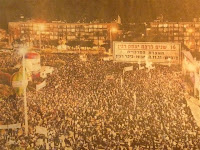

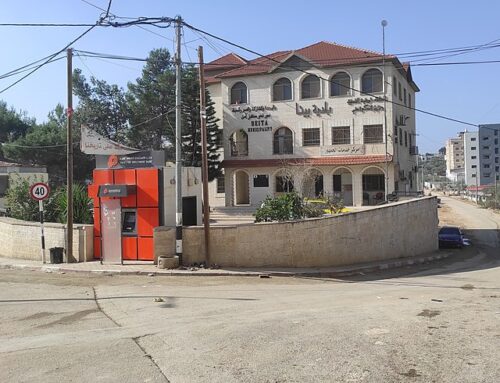
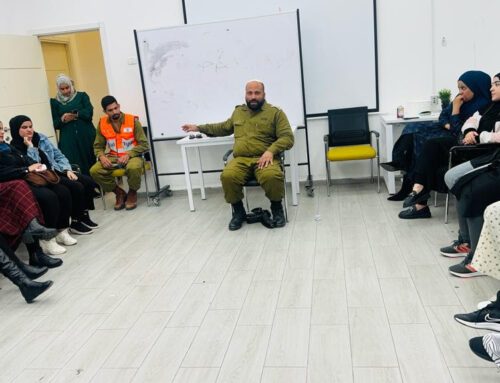
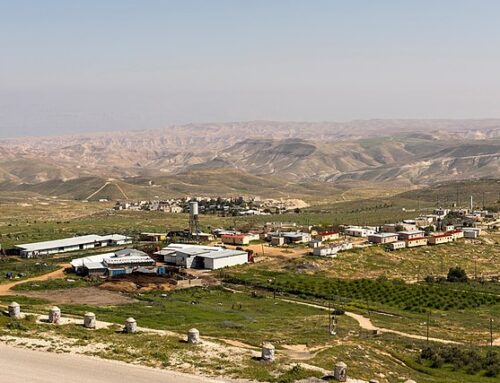
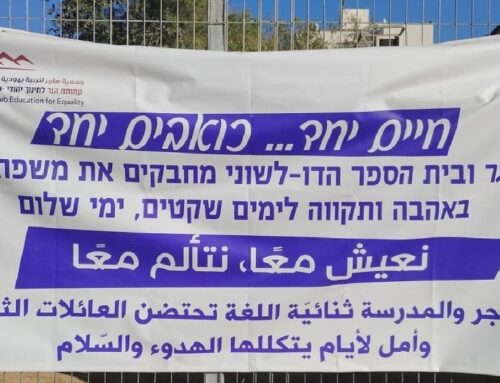
Leave A Comment